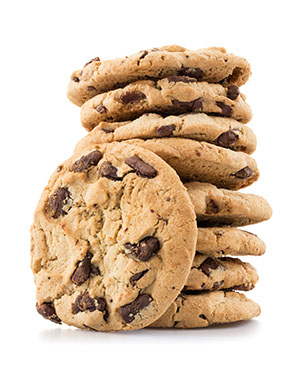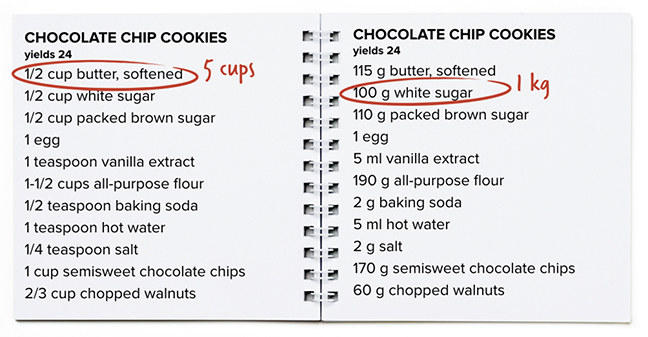SciGen Teacher Dashboard
Unit U2
Measuring Up Metric
Moving to Metric
Prefixes Are Powerful
Triple Concentration Game
Handy Measurements
Cookies for a Crowd
 Conversation: Cookies for a Crowd
Conversation: Cookies for a Crowd
Duration: Approximately 25 minutes
Given identical recipes for chocolate chip cookies using two systems of measurement, students scale each one up by a factor of 10 and discuss which system is easier to scale.
LEARNING OBJECTIVES
Students practice scaling by multiplying fractions and whole numbers.
Students practice using the base units and prefixes of the metric system.
Students practice using terms of the customary system.
Students build facility in converting units.
Students apply their knowledge of metric abbreviations.
Teacher Tips
- Optional: you may want to bring into the classroom cooking measurement tools that use the metric and/or customary systems.
- You may want to bring in the ingredients in the recipe—yum!
Teacher Tune-ups
Teaching Notes
ACTIVITY OVERVIEW
- Introduce the activity (5 min)
- Calculate conversions (10 min)
- Discuss the two tasks (10 min)
Introduce the activity (5 min)
Cookies for a Crowd
 Your cookies are VERY popular. You have made your favorite chocolate chip cookie recipe dozens of times for friends, family, and neighbors, but what if you want to make enough to feed all the families coming to a performance at your school?
Your cookies are VERY popular. You have made your favorite chocolate chip cookie recipe dozens of times for friends, family, and neighbors, but what if you want to make enough to feed all the families coming to a performance at your school?
Your work is to scale two identical recipes that make 24 cookies to recipes that yield 240 cookies! That’s a factor of 10!
This activity (see slides and PDF below) will exercise students' familiarity with the metric system and its base units and prefixes. They'll also practice their use of fractions while using the U.S. customary measurements. Students are learning how to convert using the decimal system, as well as learning the abbreviations.
:
- Have you ever followed recipes to bake or cook before?
- Have you had to double or triple a recipe to make more of the food for a crowd of people?
Calculate conversions (10 min)

Two Recipes
These are identical recipes for chocolate chip cookies, but one lists the ingredients using customary U.S. measurements and the other uses metric measurements. Your work is to scale these recipes that make 24 cookies to recipes that yield 240 cookies! That’s a factor of 10! (Your cookies are VERY popular.)
Students practice with scaling as they increase the ingredients in a recipe tenfold.
:
Tenfold increase: U.S. System
- 1⁄2 cup butter → 5 cups
- 1⁄2 cup white sugar → 5 cups
- 1⁄2 cup packed brown sugar → 5 cups
- 1 egg → 10 eggs
- 1 teaspoon vanilla extract → 10 teaspoons vanilla extract (or 3 1/3 tablespoons)
- 1 1⁄2 cups flour → 15 cups flour (also 7 1/2 pints, 3 3/4 quarts)
- 1⁄2 teaspoon baking soda → 5 teaspoons
- 1 teaspoon hot water → 10 teaspoons
- 1⁄4 teaspoon salt → 2 1/2 teaspoons
- 1 cup semisweet chocolate chips → 10 cups
- 2/3 cup chopped walnuts → 6 2/3 cups
Tenfold increase: Metric system
- 115 g butter → 1,150 g (or 1.15 kg)
- 100 g white sugar → 1 kg
- 110 g packed brown sugar → 1,100 g (or 1.1 kg)
- 1 egg → 10 eggs
- 5 ml vanilla extract → 50 ml
- 190 g flour → 1,900 g (or 1.9 kg)
- 2 g baking soda → 20 g
- 5 ml hot water → 50 ml
- 2 g salt → 20 g salt
- 170 g semisweet chocolate chips → 1,700 g or 1.7 kg
- 60 g chopped walnuts → 600 g (or .6 kg)
Discuss the two tasks (10 min)
Chew on This
Did you find it easier to convert the U.S. units or the metric units? Why?
Discuss where the two systems differ other than quantities. For example, teaspoons are used for both water and salt in the U.S. system, but in metric a volume measurement is used for water and a mass measurement is used for salt. Is one better?
Would you need a scale for both recipes?
After the students are finished, have them consider the questions in "Chew on This" as well as these other prompts:
:
- Did you make more mistakes in scaling the U.S. units or the metric units?
- Which set of scaled-up measurements would be easier to bake? (Is it easier to scoop out 15 cups of flour or 1.9kg?)
Aside from discussing where the two systems differ, your students may notice that the two systems are sometimes the same. For example, the number of eggs is a unit that is the same in both recipes.
You might challenge the students to think about commercial bakeries, who would not count eggs as they scale up recipes. Medium eggs differ in volume (and effects on the recipe) compared to extra-large eggs.
Students may recognize that scaling the metric system is much easier than scaling U.S. customary measurements.
Opinions will vary as to which system is better.
You would not need a scale for both recipes because the U.S. system does not require that any ingredients be weighed.
BETA Version - Please send comments and corrections to info@serpinstitute.org